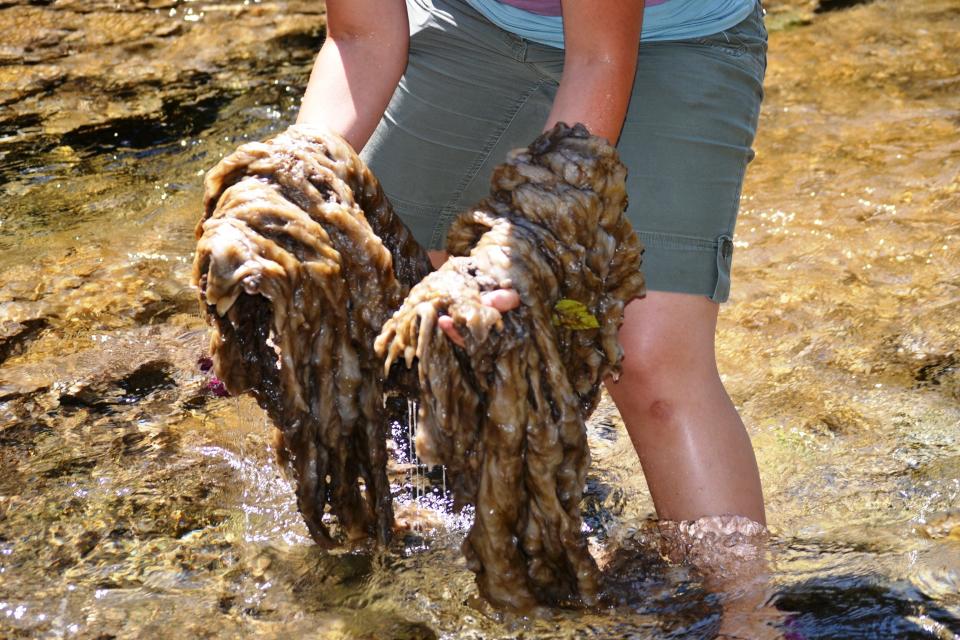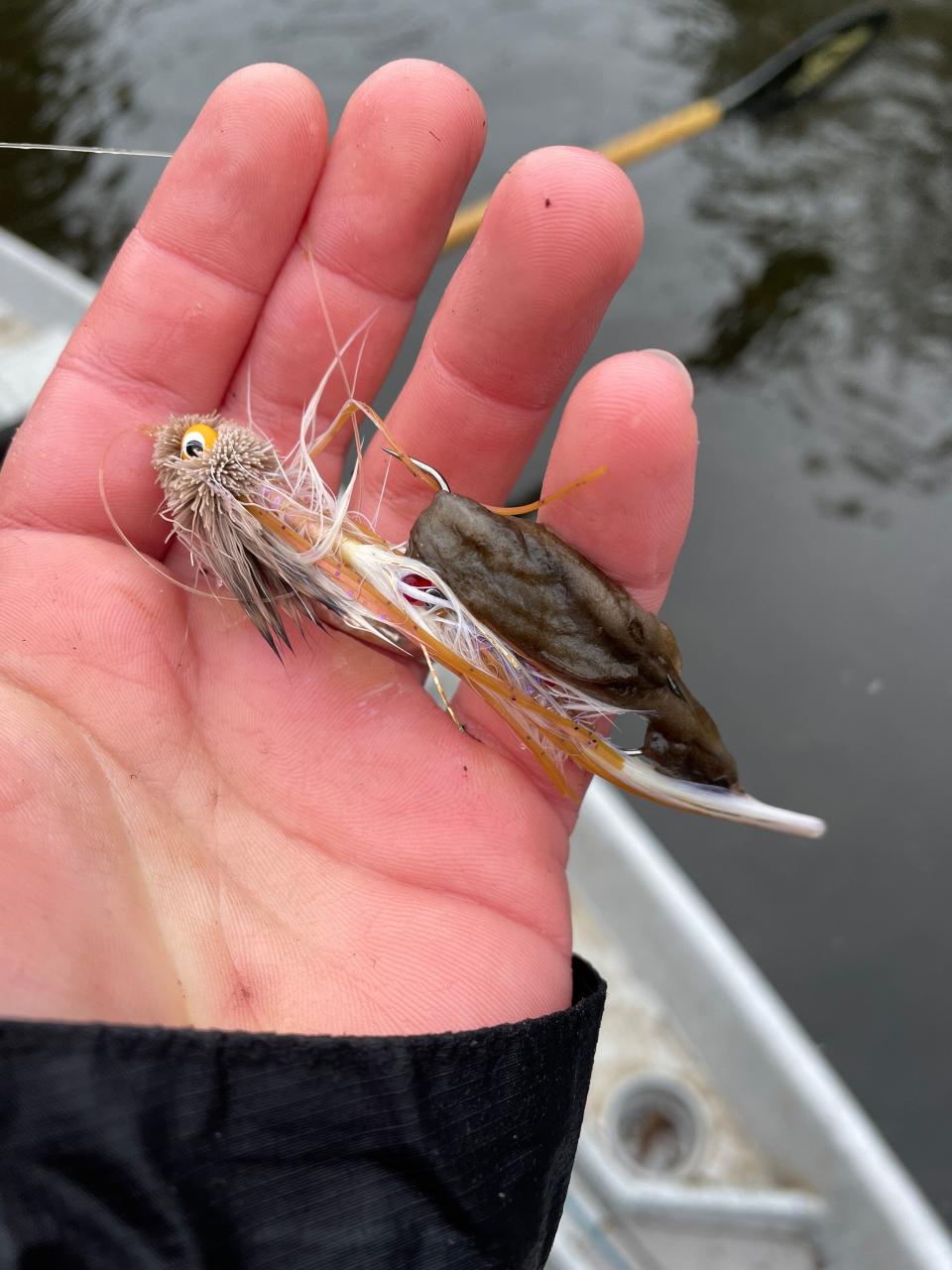'Rock snot' reaches Michigan's Lower Peninsula. Why it could be bad news for trout
It's not as slimy as it sounds, but it could mean trouble for Michigan's prized trout fishery.
The Michigan departments of Environment, Great Lakes and Energy and Natural Resources on Monday announced the detection of "rock snot" — didymo, a freshwater alga — in the Lower Peninsula for the first time.

The course, woolly textured alga was found in a portion of the Upper Manistee River in Kalkaska County. It has plagued streams in the western and eastern U.S., forming thick mats that cover river and stream bottoms, reducing the habitat for macroinvertebrates, the tiny organisms at the bottom of the food chain upon which small fish feed. Those small fish in turn provide food for Michigan's prized sports fish, such as trout.
Extensive mats of didymo were found on the Michigan side of the St. Marys River near Sault Ste. Marie in the Upper Peninsula in 2015.
"Didymo has potential to be a nasty nuisance species in Michigan’s cold-water fisheries," said Samuel Day, a water quality biologist with the Little Traverse Bay Bands of Odawa Indians. "Unlike the harmful algal blooms that plague areas of the Great Lakes due to warm temperatures and excess nutrients, didymo blooms form in cold, low-nutrient streams that most folks would generally consider pristine and great habitat for trout."
Anglers play a role in the alga's spread — and can play a role in keeping it contained, said Bill Keiper, an aquatic biologist with EGLE’s Water Resources Division.
"Didymo can attach to fishing equipment, wading gear and other hard surfaces and be moved to new waterways," he said. "With each new detection, it becomes more important for people who fish, wade or boat to clean boats and equipment, including waders, after each use."
According to Michigan State University Extension, didymo is thought to be native to Lake Superior, parts of Canada and northern Europe. Its invasive character was only recorded beginning in the late 1990s. It’s not known what conditions cause didymo to alter its native, noninvasive character and form dense invasive mats, but some speculate that climate change could be playing a role.
Didymo was found east of the Mississippi in 2005 in Tennessee, and west of the Mississippi in Montana, Utah, Colorado and South Dakota in 2004. It was even documented in New Zealand the same year.
More: Michigan's 10 most alarming invasive species: How they got here, why they're a problem
More: Invasive quagga mussels dominate Great Lakes, leave scientists trying to catch up
Day, who studied didymo in southeastern U.S. streams as a graduate student at Tennessee Technological University, discovered the Lower Peninsula algal blooms between the Three Mile Bend and Sharon Road Bridge landings on the Upper Manistee River while fishing with a friend Nov. 14. After Day examined collected samples, his findings were forwarded to the EGLE Water Resources Division, then verified by Julianne Heinlein, an aquatic ecologist and algal taxonomist with the Great Lakes Environmental Center.

Since 2015, the Michigan Invasive Species Grant Program has supported researchers at Lake Superior State University’s Center for Freshwater Research and Education in an extensive study of occurrences of didymo in the St. Marys River and Upper Peninsula waters, the risk of spread and why nuisance blooms are increasing — a phenomenon being observed worldwide.
The Manistee River detection suggests didymo’s distribution in Michigan waters may be more widespread than previously expected.
A microscopic diatom, or single-celled alga, didymo may be present but undetected in some waterways until changes in water quality cause it to "bloom" or develop long stalks, making it visible on hard surfaces in the streambed. Further understanding of changes that trigger blooms may also help combat the species’ negative environmental impacts.
Currently, there are no effective methods to eradicate didymo once it is established in a river or stream. To prevent spreading didymo and other aquatic invasive species to new locations, it is critical for recreational users to thoroughly clean, drain and dry waders, equipment and boats upon leaving a waterway:
Clean by removing mud and debris from all surfaces.
Drain water from all bilges, wells and tanks.
Dry equipment for at least five days or disinfect with hot water or a dilute bleach solution.
Anyone observing didymo in the water, either as small, cotton ball-sized patches or thick blankets with rope-like strings that flow in currents, take photos, note the location and report it by using the Midwest Invasive Species Information Network, available online at MISIN.MSU.edu or as a downloadable smartphone app. The MISIN smartphone app will take a GPS location point if a report is made at the site; it also will allow you to upload photos with a report.
Find more information on didymo and how to identify it at michigan.gov/invasives.
Contact Keith Matheny: 313-222-5021 or kmatheny@freepress.com.
This article originally appeared on Detroit Free Press: Rock snot, a concern for trout fisherman, found in lower Michigan

